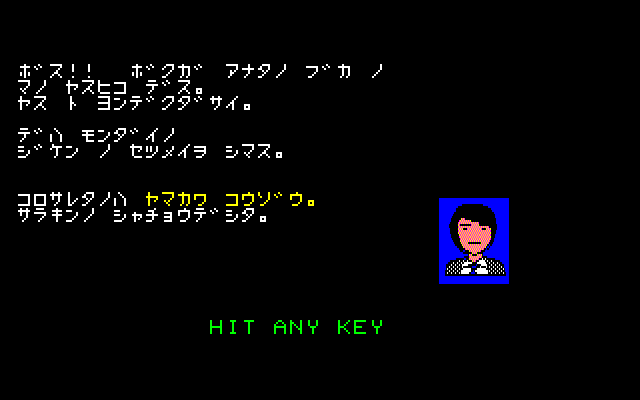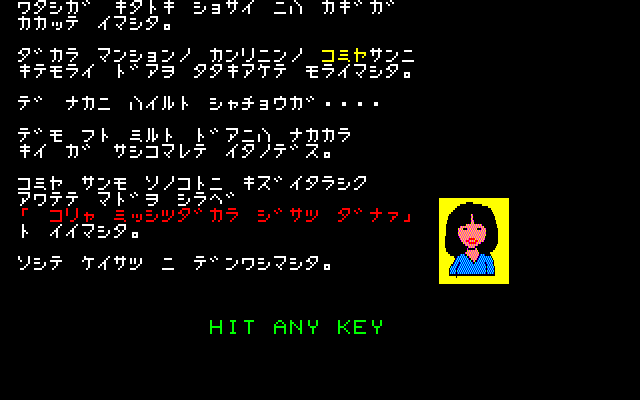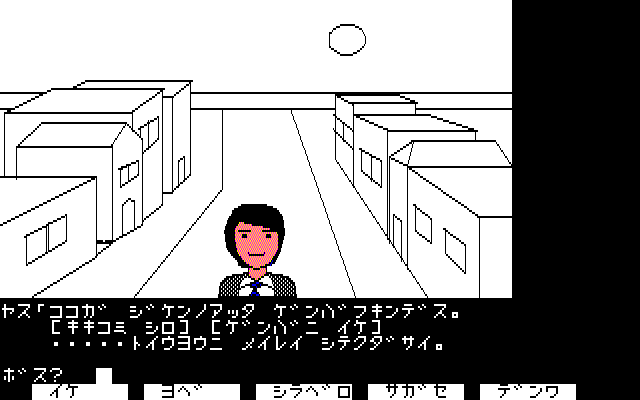Part 4: Interlude - The History Channel ~ feat. orenronen
orenronen posted:
So here’s some historical stuff.Portopia Serial Murder Case (or, if you prefer, “Pōtopia Renzoku Satsujin Jiken”) is not, in fact, a 1985 game, nor was it published by Square Enix. The game first appeared in 1983 on the PC-6001. It wasn’t technically Horii’s first game but for all intents and purposes it can be considered that. He did both the writing and the programming on it. The game was published by Enix, where Horii would later invent the modern JRPG formula with Dragon Quest, and was the first of Horii’s trilogy of mysteries, followed by Hokkaido Serial Murder Case and Karuizawa Abduction Notice. The former also got a port to the Famicom a couple of years later, but the third remains available only on early Japanese computers and cellphones.
The original version of Portopia featured a parser interface, which was popular in Japanese adventure games at the time. Heavily influenced by Scott Adams and the early works of Sierra On-Line, it featured a large image covering most of the screen with a couple lines of text beneath it and a two word parser. I’ll give its parser one thing, though - it uses the Japanese word order and asks for the commands in a “noun verb” pattern. Many other Japanese games of the era kept the English “verb noun” input which breaks any resemblance to actual Japanese grammar.
The second Horii mystery game, Hokkaido Serial Murder Case, replaced the parser with the menu system we all know and love, and was one of the earliest games to do so. Not the first (that award goes to Microcabin’s far more obscure Eiyuu Densestu Saga), but definitely the one that influenced others to follow. Parsers were gone from Japanese adventures within a year.
The game’s Famicom port was handled by Chunsoft (who will later reimagine the Japanese adventure game format with its Sound Novel series). They took the menu system introduced by Hokkaido and put it to use in the earlier game, and so demonstrated how an adventure game could even be playable on a home console. Portopia was the first Famicom adventure game, but it certainly wasn’t the last — Nintendo itself followed with a few odd titles in later years.
The original version of Portopia begins with a few screens of introduction missing in the remake:

Boss! I am your subordinate, Yasuhiko Mano. Please call me Yasu.
Let me tell you about the case we’re facing.
The victim’s name is Kouzou Yamakawa. He’s the CEO of a loan company.
The person who discovered the body is Kouzou’s assistant, Fumie Sawaki.
Kouzou did not show up at the company, so she came by to check on him this morning and found him dead.
Here, let’s hear what happened from Fumie herself.

When I got there, the door to his study was locked.
So I asked Mr. Komiya, the caretaker, to come over and he knocked down the door.
And when we came in, Mr. Yamakawa was……
But then I noticed there was a key in the door’s lock.
Mr. Komiya seemed to notice as well, and after hastily checking the window he said, “The room was locked from the inside so it must be suicide.”
Then, I called the police.
Yasu: Mr. Komiya told us the same story, so it doesn’t look like she’s lying.
So… what’s really behind this case?

…Which brings us to the game, which starts more or less the same way. Some things seemed to have changed between versions, such as giving Kouzou’s company’s a name and Komiya’s profession (I checked the Japanese Famicom version to make sure it’s not a translation issue). I’m not sure why. You’ll also notice this version of the game has the entire text in Katakana, which makes it very taxing to read. There’s a reason for that — early Japanese computers implemented language the same way many other countries around the world did - by replacing some of the extended ASCII character set in the computer’s ROM (usually the characters used to draw ASCII tables) with localised characters. There’s space for only one of the Japanese syllabaries in there, and Katakana was chosen over Hiragana. Its square characters are much easier to render in low resolution, after all.
The Famicom version adds Hiragana to the mix, and while there’s still no Kanji to be found it makes the game much easier to read through.
One final thing - the PC-6001 adventure game graphics of the era were not bitmaps, but were displayed with a series of drawing commands. Fans of American adventure games from the era will recognize the technique. The computer was slow — a scene took about 20 seconds to render — and so, since flood fills were the slowest of the drawing commands, the game offers an option to sacrifice color for speed. This is what it looks like:

…I’d almost say it looks better that way.